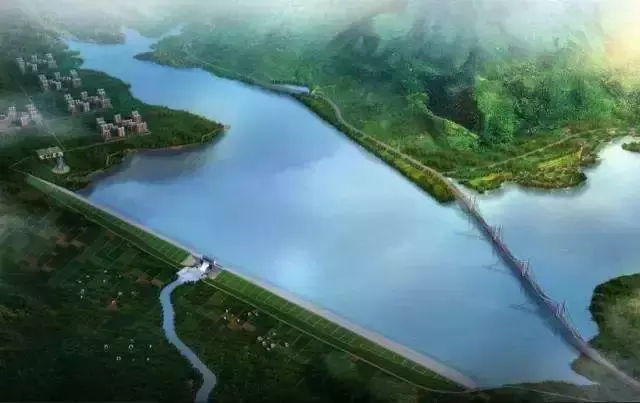
Practical practices in guarding water resources
The basic strategy for achieving sustainable environmental resource management is to protect water resources, which has been the core objective of the US Army Corps of Engineers for environmental safety over the past 30 years. Based on this, “promoting water cycle health and strengthening water storage mechanism” has become an important work goal of sustainable water resources management. Looking at the development of the United States in recent years, the main tasks of its water resources management include: 1 wetland management; 2 rainwater accumulation; 3 water storage and watershed management.

Wetland management
The central idea of wetland management is to regulate any activities involving wetlands, in or around wetlands (where wetlands include natural wetlands and constructed wetlands) in order to achieve protection, restoration, optimization, and enhance the function and value of wetlands. the goal of.
Therefore, the specific practice of wetland management is: 1 to protect the wetland by setting the designated use of the wetland, such as preventing water pollution, storing rainwater, playing a buffering function, providing wild habitat, or preventing floods (in short, It is to protect the function and value of the wetland). 2 Regulate any activity involving natural wetlands with regulations to minimize the damage or impact of development or land use projects on wetlands. 3 If the wetland is damaged or impacted, the development or activity unit shall carry out the reconstruction and restoration of the wetland according to the regulations, and the function and value of the wetland shall be continued in the form of compensation. 4 Improve the local water quality by creating artificial wetlands in areas where water quality is not up to standard, such as animal sewage constructed wetland treatment, and water environment non-point source constructed wetland treatment.
Rainwater accumulation
The purpose of rainwater accumulation is three: 1 to prevent water pollution; 2 to reduce flooding; 3 to protect water resources. Rainwater accumulation is usually achieved through the following three ways: 1 natural wetland; 2 artificial water pool; 3 water injection well.
Natural wetlands have the function of storing rainwater, and the methods of management have been mentioned before. Artificial water pools refer to the construction of a water storage pond in the ground or on the ground in an engineering manner so that rainwater runoff can stay in this structure. If the pool has a water outlet, it is called a detention pool that temporarily stores rainwater and then flows it into other water bodies. If the pond does not have a water outlet, the rainwater will remain in the groundwater for a long time, so that the rainwater will slowly reach the groundwater layer through filtration and is called a sedimentation tank. The water injection well is also constructed by engineering to construct a ditch or well in the stratum so that the rainwater runoff can quickly flow down into the groundwater reservoir. The water injection ditch is shallowly built near large rivers such as rivers and lakes, while the injection wells need to have a considerable depth to penetrate the subterranean impervious layer. Both of them are covered with gravel and sand. Both of them also have the function of filtering rainwater to guide the infiltration of rainwater into the underground reservoir, and at the same time have the effect of flood control. In recent years, due to the strong emphasis of green construction, the idea of some rainwater accumulation based on plants has also been widely discussed. Among them, the construction of rainwater gardens and low-impact development are the most concerned.

Water storage and watershed management
(1) Water storage and watershed management are generally defined as Integrated Water Resources Management (IWRM). This is a comprehensive, systematic approach to integrating water conservation and river management. It contains a variety of long-term and complex work projects that require the cooperation of all levels of government and the support of the general public. Therefore, coordination between various projects is essential, requiring full collaboration between government departments such as urban construction, water, and environmental. This management system involves various aspects, including water quality, water volume, plant protection, ecological balance, land planning and utilization, community development, and regional control mechanisms.
(2) Water storage and watershed management policies, in order for IWRM to be effective, the following policies must be in place: 1 to maintain an ecologically balanced water allocation; 2 to issue water wading permits; 3 to safely discharge domestic, industrial water and wastewater; Control of agricultural water and fertilizers/pesticides; 5 Customize water quality standards for various waters; 6 Revise regulations for groundwater extraction/use; 7 Formulate drinking water and various water use policies; 8 Soil and water conservation; 9 Integrate water/wetland conservation into national society In economic development issues; 10 strictly regulate invasive species that have an impact on water.
(3) Water storage and watershed management projects, there are eight types of watershed management projects: 1 land use planning; 2 land conservation; 3 water buffer zone protection; 4 dominant zone design; 5 flushing and sedimentation control; Good management measures; 7 non-rainwater discharge; 8 watershed guardian.
Finally, it is worth mentioning that the IWRM implementation requires a lot of money. In addition to the burden of governments at all levels, some of the costs must also be borne by the beneficiaries. Therefore, the following two taxes are imposed on the US land and housing tax: 1 Stormwater/Flood Control; 2 Clean Water Act Fee. This approach not only meets the principle of fair payment, but also increases public attention to water security.

The Example of American Rainwater Management and Its Enlightenment to the Construction of Sponge City
Hardware engineering measures
According to the ongoing projects in Prince George County, Maryland, the basic hardware engineering structure for sustainable rainwater management includes five, namely stormwater drainage, water injection wells, water injection ditches, sedimentation tanks, and detention ponds.
The combination of these hardware engineering structures constitutes five sustainable rainwater management systems: 1 storm drainage plus sedimentation tank or detention tank; 2 water injection ditch; 3 water injection ditch combination plus sedimentation tank or detention pool; 4 water injection well plus rainstorm absorption depression; The water injection well plus heavy rain absorbs the depression, sedimentation tank or detention pond. Figure 3 lists two typical sustainable stormwater management systems.
Non-engineering measures
In addition to the construction of water-conducting and other hardware facilities, in order to successfully play the role of sponge city, it is still driven by the following supporting software measures.
Keep the city clean
As we all know, rainwater pollution is the culprit of all kinds of water pollution today. If the rainwater is contaminated, the infiltration of unclean rainwater into the groundwater layer will make the originally clean groundwater no longer clean. Therefore, how to make the “clean ground” so that the rainwater can be infiltrated into the groundwater layer without being polluted is still the biggest challenge after the construction of the sponge city.
As we all know, rainwater pollution is the culprit of all kinds of water pollution today. If the rainwater is contaminated, the infiltration of unclean rainwater into the groundwater layer will make the originally clean groundwater no longer clean. Therefore, how to make the “clean ground” so that the rainwater can be infiltrated into the groundwater layer without being polluted is still the biggest challenge after the construction of the sponge city.
Improve the formulation and implementation of relevant laws and regulations
Rainwater pollution prevention and sponge city maintenance require legal norms to promote. Perfecting the clean water law and the garbage control law and its implementation, keeping the urban ground clean and letting the water seepage facilities not be dumped into garbage dumps, has become an important task that cannot be ignored after building a sponge city.
Based on this, a series of regulations such as the Rainwater Pollution Prevention Manual (SWP3) and Best Management Measures (BMPs), which are similar to the US Clean Water Act, are some of the practices we should refer to. It is the only way to keep the rain clean and clean.
Facility maintenance and function check
After the completion of the sponge city, whether it can effectively exert its expected benefits is determined by the functional status of its “water-conducting” and “water seepage” facilities. Therefore, facility maintenance and functional inspection are critical. Based on this, the system management of the sponge city must be in place and guaranteed, so that the various hardware facilities of the sponge city can be kept in the “available state” at any time, allowing the rainwater runoff to flow into the underground quickly through the water guiding and seepage facilities.
Unit coordination and system management
Sponge City is a systematic project. Its planning, construction and management involve many systems such as buildings, roads, green spaces and water systems. In the management, it is necessary to plan scientific standards, and it is necessary to coordinate the urban construction, water affairs, and environmental and other departments to fully “step by step” in order to fully realize the benefits of the sponge city.
Managed in a public affairs model
Rainwater pollution is usually caused by all residents, because the ground can not be kept clean is caused by the entire community throwing, chaos, and disorderly. Based on the principle that “everyone pollutes everyone”, the cost of rainwater pollution prevention and control should also be borne by all local residents. The construction cost of rainwater pollution prevention and hardware engineering measures in Prince George County of the United States is paid by local residents on a tax basis. Therefore, rainwater management and sponge cities need to be included in the local public affairs system to meet the principle of “who pollutes who pays for cleanup”.
Strengthening continuing education to raise public awareness
Since rainwater pollution prevention is a public matter, it requires the cooperation of all local residents to effectively achieve the goal of clean water. Therefore, every resident must realize that keeping the ground clean can keep the rain clean. With clean rain, there is safe drinking water. With clean rain, the burden of residents’ clean water will be reduced.
Let the residents realize the above causal relationship, keep the ground clean, and do not dump waste water into the rainwater discharge pipeline. Continuing education is a common practice to raise public awareness. Therefore, integrating rainwater management into the continuing education promotion curriculum is a worthwhile thing to do. Let the public know that the victims are the local people after dumping the waste water into the rainwater drainage pipeline.
Sponge City and Water Resources Management
Sponge City has the function of promoting water circulation and ecological balance. Therefore, its construction and management must be integrated into the local integrated water resources management system, and the core goal of sustainable water, water conservation and water storage. Therefore, the planning, construction, maintenance and management of the sponge city must not only have a macro awareness, but also the goals and strategies of integrated water resources management.

Conclusion
The sponge city is a manual way to strengthen the water seepage and water storage mechanism of the urban surface. It has the function of promoting natural water circulation and maintaining ecological balance. In the United States, Prince George County, Maryland, built a large-scale rainwater seepage facility in 2016-2018 to prevent flooding caused by rainwater runoff and promote the normal operation of the water cycle. Some of the facilities already built have also begun to take effect and have the desired effect. On May 26-28, 2018, Maryland and Washington, DC, suffered a severe rainstorm, and there was a serious flood in Ellicott, not far from the north of Prince George. But this torrential rain did not bring a serious flooding incident to Prince George County. This is somewhat related to the rainwater seepage facility built by Prince George County.
This flood in Maryland shows that Prince George’s practice is effective and practical in its operation, which further confirms that the county’s water management strategy is correct. The practice of Prince George County is well worthy of reference when building a sponge city in China. Its practice is not to build a sponge city by means of permeable bricks in the way of absorbing rainwater and stagnant pools, because the county believes that the seepage effect of permeable bricks is not obvious enough.
